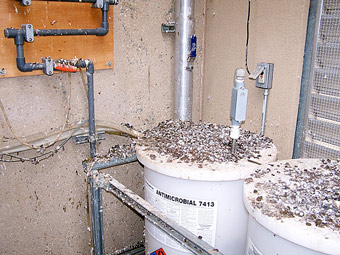Browse by Product
|
CASE STUDIES > Bird Feces Turns Industrial Facility into Toxic Stew of Pathogens
Bird Feces Turns Industrial Facility into Toxic Stew of Pathogens |
"You're going to be shocked when you see the amount of bird excrement these guys were walking through every day. And then what was behind the walls and ceiling..."


That was the report from our team working on cleanup at this industrial facility in 2014. As you can see from the photos, there are literally mountains of the stuff all over the ground, the buildings, and the equipment. What's even more alarming is what you can't see behind the walls and ceilings.
You also can't see the microbes crawling around in there. When you start to consider the amount of pathogens this mess must contain, you realize how hazardous some sites are when infested with birds and bats. Bird feces carry a number of diseases easily transmittable to humans including viruses, fungi, parasites, and bacteria. There are over 40 known viruses and 60 transmittable diseases directly attributable to birds and their fecal matter. Birds also carry up to 10 parasites on their legs, wings, and bodies, usually co-existing in active bird nests.
You don't even need to disturb these pathogens - when the feces dries out, just the wind can send them airborne. People walking by can inhale them, or the dust can get into the air ducts and travel throughout the building, spreading diseases along with it.
The problem isn't just with birds, either. Bats, rats, and other rodents also carry diseases in their feces and urine. When given a free reign to infest a property for an extended period of time, you get into situations such as that shown in these photos: a tremendous accumulation of fecal matter, feathers, fur, broken eggs, carcasses, and other smelly contaminants that need to be removed.
The thing is, it's not as easy as getting a shovel and a hose. The workers themselves need to protect themselves with proper safety gear. Certain procedures need to be followed to prevent the spread to others during cleanup as well, and to ensure the area truly is sanitized.
That's why they called in Hot Foot.
See, the Occupational Safety and Health Administration (OSHA), has very specific procedures for cleaning areas with heavy fecal accumulation based on guidelines from the Center for Disease Control and Prevention (CDC). Many people who do animal fecal matter clean up have a misconception that they can legally use any EPA-registered disinfectant. However, in commercial (non-laboratory) situations, blood, animal body fluids, bird feces, and other potentially infectious materials (OPIMs) fall under the official designation of Bloodborne Pathogens, and therefore require an EPA-registered tuberculocidal disinfectant.
This is a big step up from the standard cleaners containing quaternary ammonium chloride compounds. "Quats" as there are called are very low-level disinfectants that are ineffective except on hard surfaces that have been thoroughly pre-cleaned first. Hot Foot does not recommend the use quats for bird and animal fecal cleanup because they do not provide the high level of sanitization that the tuberculocidal intermediate-level disinfectants do. Not only do bacteria often survive quats, each new colony becomes more and more resistant to the chemical. A tuberculocidal disinfectant is the only sterilizer we use because it's the most effective. Period. Sporicidin is our product of choice.
That's ultimately good for you, too. Aside from protecting yourself should you undergo an OSHA inspection (many of our clients come to us for just that reason), you're guaranteed that the area is as clean as possible for the safety of you, your employees, and the nearby public. The added odor neutralizer is very important as well since it helps reduce the risk of birds returning due in part because of the attraction of their fecal matter.
In areas of heavy accumulations, repeat spraying may be necessary followed by removal of the material layer by layer until all contaminated matter is safely taken away. Even then, a final spraying with the sterilizer is recommended. Bags containing contaminants need to be appropriately sealed such as by layer taping around the neck of bags and then disposed of at an appropriate site following state and local regulations. (We can help you determine those regulations, and ensure they are followed.)
One note: with this amount of feces present, there is bound to be staining that cannot be removed by cleanup methods due to the uric acid present in the feces. In these cases, painting or replacement of the materials is the only way to get rid of the stains. However, no matter how stained the areas look, they will be sanitized and as free of pathogens as is possible.
Have a similar feces problem? Contact Hot Foot for a free consultation. Whether it's birds, rodents, or other pests, we can ensure a thorough cleanup that is to code.
Additional Notes: How Toxic is Bird Feces, Really?
Without doubt, the most toxic form of bird fecal matter is old, dry droppings because that is where spores of histoplasmosis (a fungus) and other diseases can be found. If these are disturbed and become airborne then they can be inhaled and infection can begin. To minimize this risk, the droppings must be wet down thoroughly. Hot Foot recommends spraying with the EPA-registered tuberculocidal sterilizing agent containing a true odor neutralizer, mentioned above. Those responsible for cleanup must also be dressed in appropriate protective clothing including a disposable outer covering such as a Tyvec suit, rubber gloves, safety glasses, and a full face respirator with HEPA filter cartridge. (In severe cases, a positive pressure respirator may be needed.)
Here are some other diseases that humans can contract if they inadvertently come into contact with pathogens left behind by birds and rodents. (Data obtained from publication from the Centers for Disease Control and Prevention (CDC) in Atlanta, GA).
- Hemorragic Fever - Results from direct contact with rodent urine or droppings as well as breathing in air contaminated with rodent urine and droppings.
- Lassa Fever - Results from breathing in air contaminated with rodent urine and droppings and direct contact with rodent urine or droppings.
- LCM (Lymphocytic Choriomeningitus) - Results from breathing in air contaminated with rodent urine and droppings and direct contact with rodent urine or droppings.
- Salmonellosis - Results from ingesting food or drink that is contaminated from rodent droppings.
- Leptospirosis - Also known as Leptospiral jaundice is transmitted via rodent urine. People are infected through contact with contaminated liquids or food.
- Lyme Disease - Caused by bacteria (Borrelia burgdorferi) which is carried by some mice. If a tick feeds on an infected rodent and then bites a person the bacteria is transferred from the rodent to the human via the bite.
- Hantavirus - This is a virus that is contracted through contact with mouse droppings. Up to 4 weeks can pass before symptoms appear. Infection with hantavirus can progress to Hantavirus Pulmonary Syndrome (HPS), which can be fatal.
The following table shows some of the dangers associated with pathogens and animals.
| Disease | Pathogen | Classifiction | Infection Hazard |
|---|---|---|---|
| Histoplamsosis | Histoplasma capsulatum | Fungal | Bird & bat feces |
| Cryptococcus | Cryptococcus neoformans | Fungal | Bird feces |
| Rabies | Rabies virus | Viral | Bat & rodent carcasses |
| Hantavirus pulmonary syndrome | Hanta virus | Viral | Bat & rodent carcasses |
| Leptospirosis | Leptospira ssp. | Bacterial | Rodent feces & urine |
| Lymphocytic Choriomeningitis | Lymphocytic choriomeningitis virus | Viral | Rodent feces & urine |
